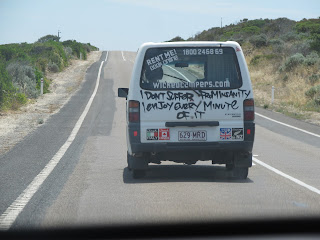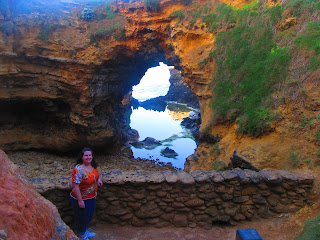 |
| Bridgewater Bay Beach, Cape Bridgewater, Australia |
 |
| Cape Bridgewater, Australia - Wind Turbines |

 The lookout itself was pretty. Not as spectacular as some of the views from
Phillip Island or along the Great Ocean Road, but pretty. This was, again, another site of two major
shipwrecks. What I found to be really
interesting and unique about this spot was the different flora here compared to
PI and GOR. The bushes were scraggly, and
the dirt was hard-packed, dotted with rocks; it was very desert-like.
The lookout itself was pretty. Not as spectacular as some of the views from
Phillip Island or along the Great Ocean Road, but pretty. This was, again, another site of two major
shipwrecks. What I found to be really
interesting and unique about this spot was the different flora here compared to
PI and GOR. The bushes were scraggly, and
the dirt was hard-packed, dotted with rocks; it was very desert-like.
 |
| Me jumping on the beach at Cape Bridgewater, Australia |
From this lookout, we headed back to Cape Bridgewater to
park and take a nice walk on Bridgewater Bay Beach. Caytie and I walked a short ways down the
beach, but did a lot of sand writing and shell “shopping.” I found some shells that had some pre-made
holes in the top perfect for a necklace (larger shell) and earrings (smaller
shells). It was a perfect walking beach,
with beautiful views, and just about empty so early in the morning! Caytie did get a great picture of me!
 |
| View of the road -- Portland to Adelaide, Australia |
 |
| View of the road -- Portland to Adelaide, Australia |
From Cape Bridgewater, we headed off along Princes Highway
toward Adelaide. We thought taking the
coastal route would be better views than inland. I don’t know if it was, but I also don’t know
if it could have been any worse driving inland!
As we drove along Coorong National Park, it was some of the most boring
views ever for the majority of the drive.
The views were either flat fields as far as you could see (which does
have a beauty of its own, but not for hours on end) or “scrub” bush (again, its
own beauty, just not for hours and hours) that lined either side of the
highway. When the scrub bush broke,
however, we got to see some pretty cool dried up salt lake beds. That was actually the highlight of the whole
drive. Caytie drove, and I played
chicken with the scrub brush trying to get pictures of the dried-up lakes!
 |
| Dried-up salt lakes along the road between Portland to Adelaide, Australia |
Part of why I believe that it was so boring to us is that we
had only one other drive that was hours long with so few scenic stops. That long drive was on our third day from the
Blue Mountains to Canberra, and we were still so excited; also, it was twilight,
we had seen our first kangaroo, and then it was dark. This drive from Portland to Adelaide was over
six hours, and there were no kangaroos, only dead wombats (I believe), feet in
the air. I expected their eyes to have an
“X” over them like in the cartoons! We
actually saw them dead all over Australia, but I think seeing them on this
stretch of road added a little excitement.
One last thing that probably didn’t help us on that drive is that the
windshield was INUNDATED with bug guts.
It was fairly difficult to see out of the windshield it was so bad.
 We stopped in a small town for lunch, and it was really
good! I got a BBQ Chicken Pizza, no
capsicum. What is that, you ask? Well, I didn’t know either, so Caytie and I
asked our waitress. She said it was a
round green vegetable that was sweet.
Okay…still no clue. The next
table over said “You Americans would call it a green pepper.” Aahhh.
Got it! It was nice to be out of
the car, and lunch was really great. One
of the things on the menu (not the first time we had seen it either) was weinersnitchel. Who knew that was so big in Australia?!
We stopped in a small town for lunch, and it was really
good! I got a BBQ Chicken Pizza, no
capsicum. What is that, you ask? Well, I didn’t know either, so Caytie and I
asked our waitress. She said it was a
round green vegetable that was sweet.
Okay…still no clue. The next
table over said “You Americans would call it a green pepper.” Aahhh.
Got it! It was nice to be out of
the car, and lunch was really great. One
of the things on the menu (not the first time we had seen it either) was weinersnitchel. Who knew that was so big in Australia?! We got back on the road, and got behind the slowest
vehicle ever, and it was difficult to pass it because of the curves in the road
and the cars coming the opposite way. I
think we were stuck behind the van for about 45 minutes or so. That might have been part of the “boring” of
the drive! It was, however, a very
interesting vehicle. It was one of the Wicked
Campers. We had seen them everywhere on
the road as we drove around Australia.
The vans have some seriously funny sayings on the back of them too!
We got back on the road, and got behind the slowest
vehicle ever, and it was difficult to pass it because of the curves in the road
and the cars coming the opposite way. I
think we were stuck behind the van for about 45 minutes or so. That might have been part of the “boring” of
the drive! It was, however, a very
interesting vehicle. It was one of the Wicked
Campers. We had seen them everywhere on
the road as we drove around Australia.
The vans have some seriously funny sayings on the back of them too! Well, after passing the Wicked van and getting past the
dried up lakes, we finally hit some hills.
This was about 1 hour or so outside of Adelaide. We arrived in Adelaide and found our
hotel. Ambassadors Hotel was an older
building directly downtown and had various classes of rooms from backpacker
(which we stayed in) to suites. The area
where our room was located was down some twisty (skinny) halls, and both Caytie
and I think that they were probably once servants’ quarters. The other unique thing about the hotel was
the elevator. It was tiny. As in any more people than Caytie and I with
one suitcase each and you’d have some problems.
Also, there were two doors…one at the front and one to the right (if
you’re facing the front). It was pretty cool.
Well, after passing the Wicked van and getting past the
dried up lakes, we finally hit some hills.
This was about 1 hour or so outside of Adelaide. We arrived in Adelaide and found our
hotel. Ambassadors Hotel was an older
building directly downtown and had various classes of rooms from backpacker
(which we stayed in) to suites. The area
where our room was located was down some twisty (skinny) halls, and both Caytie
and I think that they were probably once servants’ quarters. The other unique thing about the hotel was
the elevator. It was tiny. As in any more people than Caytie and I with
one suitcase each and you’d have some problems.
Also, there were two doors…one at the front and one to the right (if
you’re facing the front). It was pretty cool.
I didn’t realize until we arrived in Adelaide, but I had forgotten
to check out the parking situation for the hotel when planning our stay there. We had to park in a ramp, walk to the hotel,
check in, and then move our car to the hotel’s “cheaper” parking ramp! After we got those things done, we called
Uchoti (our whole reason for visiting Australia) to let her know we were in
town and to make plans for the next day!
We at an early dinner in the hotel. The dining room was dark woods and marble
with some very cool light fixtures. For
dinner, I had a steak and mushroom pie, which was really good.
After dinner, Caytie and I read and relaxed before heading
to bed.











































